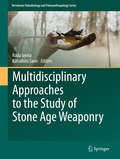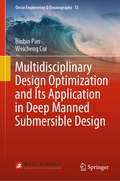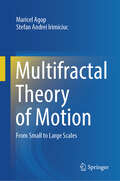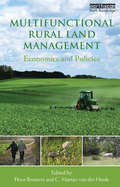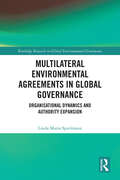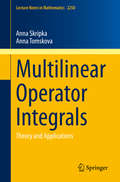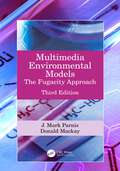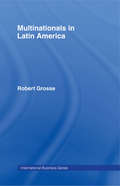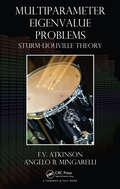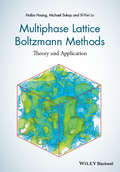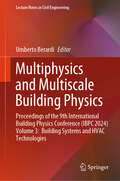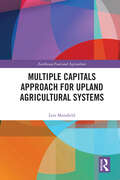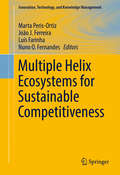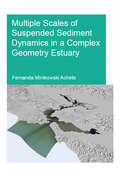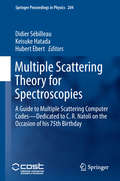- Table View
- List View
Multidimensional Approach to Quality of Life Issues: A Spatial Analysis
by Braj Raj Kumar SinhaThis comprehensive volume provides a broad overview of quality of life issues covering a wide geographical region: North America, Europe, parts of Africa, East Asia, and South Asia. Spread over more than 25 chapters, it includes the latest findings from these regions to provide a multidisciplinary account of the major dimensions of quality of life, and therefore has a vast scope. The volume is divided into four thematic parts: theoretical dimension; Demographic dimension; socio-cultural and economic dimensions; and urban and environment related dimensions. Extensive maps, diagrams and tables accompany the discussions and facilitate understanding. This is an indispensable reference and serves the interest of students and scholars of human geography, economics, demography, sociology, anthropology, social work, and philosophy. It is particularly useful for those engaged in further research on quality of life issues.
Multidimensional Periodic Schrödinger Operator: Perturbation Theories for High Energy Regions and Their Applications (Springer Tracts in Modern Physics #291)
by Oktay VelievThis book describes the direct and inverse problems of the multidimensional Schrödinger operator with a periodic potential, a topic that is especially important in perturbation theory, constructive determination of spectral invariants and finding the periodic potential from the given Bloch eigenvalues. It provides a detailed derivation of the asymptotic formulas for Bloch eigenvalues and Bloch functions in arbitrary dimensions while constructing and estimating the measure of the iso-energetic surfaces in the high-energy regime. Moreover, it presents a unique method proving the validity of the Bethe–Sommerfeld conjecture for arbitrary dimensions and arbitrary lattices. Using the perturbation theory constructed, it determines the spectral invariants of the multidimensional operator from the given Bloch eigenvalues. Some of these invariants are explicitly expressed by the Fourier coefficients of the potential, making it possible to determine the potential constructively using Bloch eigenvalues as input data. Lastly, the book presents an algorithm for the unique determination of the potential.This updated and significantly expanded third edition features an extension of this framework to all dimensions, offering a now complete theory of self-adjoint Schrödinger operators within periodic potentials. Drawing from recent advancements in mathematical analysis, this edition delves even deeper into the intricacies of the subject. It explores the connections between the multidimensional Schrödinger operator, periodic potentials, and other fundamental areas of mathematical physics. The book's comprehensive approach equips both students and researchers with the tools to tackle complex problems and contribute to the ongoing exploration of quantum phenomena.
Multidimensional Periodic Schrödinger Operator: Perturbation Theory and Applications
by Oktay VelievThis book describes the direct and inverse problems of the multidimensional Schrödinger operator with a periodic potential, a topic that is especially important in perturbation theory, constructive determination of spectral invariants and finding the periodic potential from the given Bloch eigenvalues. It provides a detailed derivation of the asymptotic formulas for Bloch eigenvalues and Bloch functions in arbitrary dimensions while constructing and estimating the measure of the iso-energetic surfaces in the high-energy regime. Moreover, it presents a unique method proving the validity of the Bethe–Sommerfeld conjecture for arbitrary dimensions and arbitrary lattices. Using the perturbation theory constructed, it determines the spectral invariants of the multidimensional operator from the given Bloch eigenvalues. Some of these invariants are explicitly expressed by the Fourier coefficients of the potential, making it possible to determine the potential constructively using Bloch eigenvalues as input data. Lastly, the book presents an algorithm for the unique determination of the potential. This updated second edition includes an additional chapter that specifically focuses on lower-dimensional cases, providing the basis for the higher-dimensional considerations of the chapters that follow.
Multidisciplinary Approaches to the Study of Stone Age Weaponry
by Radu Iovita Katsuhiro SanoThe objective of this volume is to showcase the contemporary state of research on recognizing and evaluating the performance of stone age weapons from a variety of viewpoints, including investigating their cognitive and evolutionary significance. New archaeological finds and experimental studies have helped to bring this subject back to the forefront of human origins research. In the last few years, investigations have expanded beyond examining the tools themselves to include studies of damage caused by projectile weapons on animal and hominin bones and skeletal asymmetries in ancient hominin populations. Only recently has there been a growing interest in controlled and replicative experiments. Through this book readers will be updated in the state of knowledge through a multidisciplinary scientific reconstruction of prehistoric weapon use and its implications. Contributions from expert authors are organized into three themed parts: recognizing weapon use (experimental and archaeological studies of impact traces), performance of weapon systems (factors influencing penetration depth etc. ), and behavioral and evolutionary ramifications (cognitive and ecological effects of using different weapons).
Multidisciplinary Design Optimization and Its Application in Deep Manned Submersible Design (Ocean Engineering & Oceanography #13)
by Weicheng Cui Binbin PanThis book investigates Reliability-based Multidisciplinary Design Optimization (RBMDO) theory and its application in the design of deep manned submersibles (DMSs). Multidisciplinary Design Optimization (MDO) is an effective design method for large engineering systems like aircraft, warships, and satellites, which require designers and engineers from various disciplines to cooperate with each other. MDO can be used to handle the conflicts that arise between these disciplines, and focuses on the optimal design of the system as a whole. However, it can also push designs to the brink of failure. In order to keep the system balanced, Reliability-based Design (RBD) must be incorporated into MDO. Consequently, new algorithms and methods have to be developed for RBMDO theory.This book provides an essential overview of MDO, RBD, and RBMDO and subsequently introduces key algorithms and methods by means of case analyses. In closing, it introduces readers to the design of DMSs and applies RBMDO methods to the design of the manned hull and the general concept design. The book is intended for all students and researchers who are interested in system design theory, and for engineers working on large, complex engineering systems.
Multifractal Theory of Motion: From Small to Large Scales
by Maricel Agop Stefan Andrei IrimiciucThis book aims to present the topic of nonlinear and chaotic dynamics in a manner that is useful and beneficial to students and young researchers from various domains such as physics, mathematics, biology, or even medicine. A very important aspect of that topic is that the constraints of determinism do not imply a regular behavior or do not rely on predictability in describing the dynamics of natural systems. Exploring the evolution of natural systems has a great impact nowadays on a wide range of scientific domains. The dynamics of populations, cardiac fibrillation, communication systems, fluid flow, and atmospheric systems are just a few topics in which nonlinearity and chaos are a regular manifestation. This leads to the idea that it is necessary to find universal laws that govern these dynamics. The aforementioned variety in scientific topics is also sustained by an exponential interest in recent decades from readers in the scientific community and the non-scientific one as well. The book is devoted to the nonlinear and chaotic dynamics topic, a domain that is both trans- and multi-disciplinary and has been the focus of the scientific community in past decades.
Multifunctional Land Uses in Africa: Sustainable Food Security Solutions (Earthscan Food and Agriculture)
by Elisabeth Simelton Madelene OstwaldThis book presents contemporary case studies of land use, management practices, and innovation in Africa with a view to exploring how multifunctional land uses can alleviate food insecurity and poverty. Food security and livelihoods in Africa face multiple challenges in the form of feeding a growing population on declining land areas under the impacts of climate change. The overall question is what kind of farming systems can provide resilient livelihoods? This volume presents a selection of existing farming systems that demonstrate how more efficient use of land and natural resources, labour and other inputs can have positive effects on household food security and livelihoods. It examines how aquaculture, integrated water management, peri-urban farming systems, climate-smart agriculture practices and parkland agroforestry contribute multiple benefits. Drawing on case studies from Kenya, Ethiopia, Nigeria and Burkina Faso, contributed by young African scientists, this book provides a unique perspective on multifunctional land use in Africa and illustrates how non-conventional uses can be profitable while promoting social and environmental sustainability. Tapping into the global discussion on land scarcity and linking food security to existing land use change processes, this volume will stimulate readers looking for diversified land uses that are compatible with both household and national food security ambitions. This book will be of great interest to students and scholars of African development, agriculture, food security, land use and environmental management, as well as sustainable development more generally, in addition to policymakers and practitioners working in these areas.
Multifunctional Rural Land Management: Economics and Policies
by C. Martijn van der Heide Brouwer FloorThe increasing demand for rural land and its natural resources is creating competition and conflicts. Many interested parties, including farmers, nature conservationists, rural residents and tourists, compete for the same space. Especially in densely populated areas, agriculture, recreation, urban and suburban growth and infrastructure development exert a constant pressure on rural areas. Because land is a finite resource, spatial policies which are formulated and implemented to increase the area allocated to one use imply a decrease in land available for other uses. As a result, at many locations, multi-purpose land use is becoming increasingly important. This notion of multi-purpose land use is reflected in the term 'multifunctionality'. This volume provides insights into viable strategies of sustainable management practices allowing multiple functions sustained by agriculture and natural resources in rural areas. It shows how the rural economy and policies can balance and cope with these competing demands and includes numerous case studies from Europe, North America and developing countries.
Multilateral Environmental Agreements in Global Governance: Organisational Dynamics and Authority Expansion (Routledge Research in Global Environmental Governance)
by Linda Maria SpielmannThis book proposes a conceptualisation of Multilateral Environmental Agreements as a form of International Organisations, exploring the ways in which they have expanded over time by discussing the nuances of authority in global governance.Multilateral Environmental Agreements are the key type of cooperation between states to address environmental concerns globally. While their activities regularly attract much attention from an academic and non-academic audience, their peculiar hybrid nature in-between treaties and full-fledged International Organisations, means they are often underestimated. This book proposes a new and innovative conceptualisation of Multilateral Environmental Agreements as a specific type of International Organisation which allows for a more accurate understanding of their dynamic nature, and uncovers expansive tendencies which have so far gone almost completely unnoticed. Based on a modern understanding of authority in global governance, the book shows how Multilateral Environmental Agreements represent a separate entity, and expand beyond the boundaries originally set by their member states. The book draws upon the neo-functionalist concept of spillover, as well as multiple other theoretical frameworks, to identify the two main drivers of expansion in Multilateral Environmental Agreements. To illustrate these drivers, the empirical chapters conduct six structured case studies, analysing specific cases of authority expansion in ozone and climate protection, including the Green Climate Fund under the UN Framework Convention on Climate Change. Overall, this book offers an invaluable contribution to the theoretical discussion on informal types of organisations, and provides new and extensive empirical insights into unexpected past and recent developments in global environmental governance.As such, this book will be of great interest to students and scholars of International Relations and International Law who focus on informal types of cooperation and legislation, dynamic institutional development, and international environmental politics generally.
Multilinear Operator Integrals: Theory and Applications (Lecture Notes in Mathematics #2250)
by Anna Skripka Anna TomskovaThis book provides a comprehensive treatment of multilinear operator integral techniques. The exposition is structured to be suitable for a course on methods and applications of multilinear operator integrals and also as a research aid. The ideas and contributions to the field are surveyed and up-to-date results and methods are presented. Most practical constructions of multiple operator integrals are included along with fundamental technical results and major applications to smoothness properties of operator functions (Lipschitz and Hölder continuity, differentiability), approximation of operator functions, spectral shift functions, spectral flow in the setting of noncommutative geometry, quantum differentiability, and differentiability of noncommutative L^p-norms. Main ideas are demonstrated in simpler cases, while more involved, technical proofs are outlined and supplemented with references. Selected open problems in the field are also presented.
Multimedia Environmental Models: The Fugacity Approach
by Donald Mackay J. Mark ParnisMultimedia Environmental Models: The Fugacity Approach, Third Edition, takes a broad approach of viewing chemical behavior in the total biosphere of connected biotic and abiotic compartments. Chemicals are subject to the laws of "mass balance," a constraint that provides the opportunity to establish quantitative expressions for chemical fate that are central to chemical management and regulatory legislation. This book employs both the conventional concentration-based procedures and those based on application of the more elegant and powerful concept of fugacity to characterize equilibrium, steady-state distribution, and time-dependent transport between environmental phases such as air, water, and soil. Organic chemicals are emphasized because they are more easily generalized when assessing environmental behavior.Features Illustrates professional approaches to calculating the fate of chemicals in the environment Explicitly details all worked examples in an annotated step-by-step fashion Presents real-life freely downloadable models of use to government, industry, and private consulting professionals and students alike Clarifies symbols and notation
Multinational Business and Transnational Regions: A Transnational Business History of Energy Transition in the Rhine Region, 1945-1973 (Routledge International Studies in Business History)
by Marten BoonMultinational Enterprise and Transnational Regions offers an innovative approach to the study of the history of transnational economic regions. The Rhine valley is such a region comprising the cities and areas along the Rhine river and its tributaries. The transition from coal to oil that unfolded between 1945 and 1973 rapidly transformed the region, shattering some of the old river-based connections and creating new ones with the introduction of large-scale cross-border oil pipelines. Multinational enterprises shaped these new regional connections but divergent national government responses gave rise to differentiated development in different parts of the Rhine valley. Multinational Enterprise and Transnational Regions argues that processes of regional change should be understood from transnational interconnections rather than from local or national perspectives. This book uses a transnational business history methodology to tease out the region’s transformation and to circumvent the national bias in public sources. It will be of relevance to academics and researchers with an interest in regional and transnational European history, international business, environmental history, and business history, as well as practitioners interested in the oil industry, energy and energy history, business history and international business, and associated disciplines.
Multinationals in Latin America (International Business Series)
by Robert GrosseMultinational enterprises are particularly strong in Latin America and sensitive to political and economic changes there - the currently emerging debt crisis is likely to have far-ranging effects. This book considers multinationals in Latin America, both those from inside and those from outside the region, and discusses the major issues relating to them, e.g. trans-national regulation and the government/business relationships. It sets the discussions against the background of other work and theories of multinational enterprise. Novel features include the development of the author's bargaining theory of multinational enterprise and the attempt to create a systematic method for evaluating MNE acceptability for host governments (an important consideration since the relationship between multinationals and governments, particularly the way a government perceives a multinational, is crucial). The book concludes by assessing current trends and likely future developments.
Multiobjective Shape Design in Electricity and Magnetism
by Paolo Di BarbaMultiobjective Shape Design in Electricity and Magnetism is entirely focused on electric and magnetic field synthesis, with special emphasis on the optimal shape design of devices when conflicting objectives are to be fulfilled. Direct problems are solved by means of finite-element analysis, while evolutionary computing is used to solve multiobjective inverse problems. This approach, which is original, is coherently developed throughout the whole manuscript. The use of game theory, dynamic optimisation, and Bayesian imaging strengthens the originality of the book. Covering the development of multiobjective optimisation in the past ten years, Multiobjective Shape Design in Electricity and Magnetism is a concise, comprehensive and up-to-date introduction to this research field, which is growing in the community of electricity and magnetism. Theoretical issues are illustrated by practical examples. In particular, a test problem is solved by different methods so that, by comparison of results, advantages and limitations of the various methods are made clear.
Multiparameter Eigenvalue Problems: Sturm-Liouville Theory
by F.V. Atkinson Angelo B. MingarelliOne of the masters in the differential equations community, the late F.V. Atkinson contributed seminal research to multiparameter spectral theory and Sturm-Liouville theory. His ideas and techniques have long inspired researchers and continue to stimulate discussion. With the help of co-author Angelo B. Mingarelli, Multiparameter Eigenvalue Problem
Multiphase Lattice Boltzmann Methods: Theory and Application
by Haibo Huang Michael Sukop Xiyun LuTheory and Application of Multiphase Lattice Boltzmann Methods presents a comprehensive review of all popular multiphase Lattice Boltzmann Methods developed thus far and is aimed at researchers and practitioners within relevant Earth Science disciplines as well as Petroleum, Chemical, Mechanical and Geological Engineering. Clearly structured throughout, this book will be an invaluable reference on the current state of all popular multiphase Lattice Boltzmann Methods (LBMs). The advantages and disadvantages of each model are presented in an accessible manner to enable the reader to choose the model most suitable for the problems they are interested in. The book is targeted at graduate students and researchers who plan to investigate multiphase flows using LBMs. Throughout the text most of the popular multiphase LBMs are analyzed both theoretically and through numerical simulation. The authors present many of the mathematical derivations of the models in greater detail than is currently found in the existing literature. The approach to understanding and classifying the various models is principally based on simulation compared against analytical and observational results and discovery of undesirable terms in the derived macroscopic equations and sometimes their correction. A repository of FORTRAN codes for multiphase LBM models is also provided.
Multiphysics and Multiscale Building Physics: Proceedings of the 9th International Building Physics Conference (IBPC 2024) Volume 1: Moisture and Materials (Lecture Notes in Civil Engineering #552)
by Umberto BerardiThis book contains selected papers presented at the 9th edition of the official triennial conference of the International Association of Building Physics (IABP), held in Toronto, Ontario, Canada on 25-27 July, 2024. The contents make valuable contributions to academic researchers and practioners of the building sector. Readers will encounter new ideas for realizing more efficient and resilient buildings and cities. The approach followed in the book aims to explore how building physics can be explored using multi domains and scales.
Multiphysics and Multiscale Building Physics: Proceedings of the 9th International Building Physics Conference (IBPC 2024) Volume 2: Urban Physics and Energy Efficiency (Lecture Notes in Civil Engineering #553)
by Umberto BerardiThis book contains selected papers presented at the 9th edition of the official triennial conference of the International Association of Building Physics (IABP), held in Toronto, Ontario, Canada on 25-27 July, 2024. The contents make valuable contributions to academic researchers and practioners of the building sector. Readers will encounter new ideas for realizing more efficient and resilient buildings and cities. The approach followed in the book aims to explore how building physics can be explored using multi domains and scales.
Multiphysics and Multiscale Building Physics: Proceedings of the 9th International Building Physics Conference (IBPC 2024) Volume 3: Building Systems and HVAC Technologies (Lecture Notes in Civil Engineering #554)
by Umberto BerardiThis book contains selected papers presented at the 9th edition of the official triennial conference of the International Association of Building Physics (IABP), held in Toronto, Ontario, Canada on 25-27 July, 2024. The contents make valuable contributions to academic researchers and practioners of the building sector. Readers will encounter new ideas for realizing more efficient and resilient buildings and cities. The approach followed in the book aims to explore how building physics can be explored using multi domains and scales.
Multiphysics and Multiscale Building Physics: Proceedings of the 9th International Building Physics Conference (IBPC 2024) Volume 4: Indoor Air Quality (IAQ), Lighting and Acoustics (Lecture Notes in Civil Engineering #555)
by Umberto BerardiThis book contains selected papers presented at the 9th edition of the official triennial conference of the International Association of Building Physics (IABP), held in Toronto, Ontario, Canada on 25-27 July, 2024. The contents make valuable contributions to academic researchers and practioners of the building sector. Readers will encounter new ideas for realizing more efficient and resilient buildings and cities. The approach followed in the book aims to explore how building physics can be explored using multi domains and scales.
Multiple Capitals Approach for Upland Agricultural Systems (Earthscan Food and Agriculture)
by Lois MansfieldThis book focuses on upland agricultural systems and applies a multiple capitals approach to explain what they can provide at a time when many are struggling to survive.Marginal upland agricultural systems have been distorted and derailed by modern economics, politics, and the drive to intensification. This book argues for the application of a multiple capitals approach to resource management challenges for marginal upland agricultural communities. Instead of considering what upland agricultural systems lack, the book showcases how a multiple capitals framework can demonstrate the importance, interrelationships, and relevance of the suite of capitals (natural, human, social, cultural, and financial) to achieve better outcomes for upland communities, broader ecosystem services, and wider society more generally. It is designed to connect theory to practice to provide underpinning knowledge and guidance to help upland agricultural communities thrive. Drawing on case studies from the UK and Japan, as well as making comparisons with Central and South American countries, the book recommends tools for monitoring different forms of capital and suggests a management process driven by multiple capitals to create resilience in upland agricultural systems.This book will be of great interest to students and scholars of agriculture, natural resource management, ecosystem services, rural development, and those interested in applying a multiple capitals approach more widely within policy and landscape management contexts.
Multiple Dirichlet Series, L-functions and Automorphic Forms
by Daniel Bump Solomon Friedberg Dorian GoldfeldMultiple Dirichlet Series, L-functions and Automorphic Forms gives the latest advances in the rapidly developing subject of Multiple Dirichlet Series, an area with origins in the theory of automorphic forms that exhibits surprising and deep connections to crystal graphs and mathematical physics. As such, it represents a new way in which areas including number theory, combinatorics, statistical mechanics, and quantum groups are seen to fit together. The volume also includes papers on automorphic forms and L-functions and related number-theoretic topics. This volume will be a valuable resource for graduate students and researchers in number theory, combinatorics, representation theory, mathematical physics, and special functions. Contributors: J. Beineke, B. Brubaker, D. Bump, G. Chinta, G. Cornelissen, C.A. Diaconu, S. Frechette, S. Friedberg, P. Garrett, D. Goldfeld, P.E. Gunnells, B. Heim, J. Hundley, D. Ivanov, Y. Komori, A.V. Kontorovich, O. Lorscheid, K. Matsumoto, P.J. McNamara, S.J. Patterson, M. Suzuki, H. Tsumura.
Multiple Helix Ecosystems for Sustainable Competitiveness
by Marta Peris-Ortiz João J. Ferreira Luís Farinha Nuno O. FernandesThis book discusses the main issues, challenges, opportunities, andtrends involving the interactions between academia, industry, government and society. Specifically, it aims to explore how these interactions enhance the ways inwhich companies deliver products and services in order to achieve sustainablecompetitiveness in the marketplace. Sustainable competitiveness has been widely discussed by academics andpractitioners, considering the importance of protecting the environment whilesustaining the economic goals of organizations. The Quintuple Helix innovation modelis a framework for facilitating knowledge, innovation and sustainablecompetitive advantage. It embeds the Triple and the Quadruple Helix models byadding a fifth helix, the "natural environment. " The Triple Helix model focuseson the university-industry-government triad, while the Quadruple adds civilsociety (the media- and culture-driven public) as a fourth helix. The Quintuple Helix model facilitates research, public policy, andpractical application of sustainable competitiveness principles. Applying themost recent developments and theoretical insights of this model, thecontributors to this volume address such questions as: how do government,academia, industry and civil society actors interact for promoting sustainablecompetitiveness at the country (regional) level? How do these actors influencesustainable operations management at the company (business) level? In so doing,they shed new light on the dynamics of economic growth, sustainability andcompetitiveness.
Multiple Scales of Suspended Sediment Dynamics in a Complex Geometry Estuary (IHE Delft PhD Thesis Series)
by Fernanda Minikowski AcheteMany estuaries are located in urbanized, highly engineered environments. Cohesive sediment plays an important role due to its link with estuarine health and ecology. An important ecological parameter is the suspended sediment concentration (SSC) translated into turbidity levels and sediment budget. This study contributes to investigate and forecast turbidity levels and sediment budget variability at San Francisco Bay-Delta system at a variety of spatial and temporal scales applying a flexible mesh process-based model (Delft3D FM). It is possible to have a robust sediment model, which reproduces 90% of the yearly data derived sediment budget, with simple model settings, like applying one mud fraction and a simple bottom sediment distribution. This finding opens the horizon for modeling less monitored estuaries.Comparing two case studies, i.e. the Sacramento-San Joaquin Delta and Alviso Slough, a classification for estuaries regarding the main sediment dynamic forcing is proposed: event-driven estuary (Delta) and tide-driven estuary (Alviso Slough). In the event-driven estuaries, the rivers are the main sediment source and the tides have minor impact in the net sediment transport. In the tide-driven estuaries, the main sediment source is the bottom sediment and the tide asymmetry defines the net sediment transport.This research also makes advances in connecting different scientific fields and developing a managerial tool to support decision making. It provides the basis to a chain of models, which goes from the hydrodynamics, to suspended sediment, to phytoplankton, to fish, clams and marshes.
Multiple Scattering Theory for Spectroscopies: A Guide To Multiple Scattering Computer Codes -- Dedicated To C. R. Natoli On The Occasion Of His 75th Birthday (Springer Proceedings In Physics #204)
by Didier Sébilleau Keisuke Hatada Hubert EbertThis edited book, based on material presented at the EU Spec Training School on Multiple Scattering Codes and the following MSNano Conference, is divided into two distinct parts. The first part, subtitled “basic knowledge”, provides the basics of the multiple scattering description in spectroscopies, enabling readers to understand the physics behind the various multiple scattering codes available for modelling spectroscopies. The second part, “extended knowledge”, presents “state- of-the-art” short chapters on specific subjects associated with improving of the actual description of spectroscopies within the multiple scattering formalism, such as inelastic processes, or precise examples of modelling.



